You guys rock! I've been coming here for weeks identifying the birds in our backyard for my daughter's school project. Thanks so much for this valuable resource.
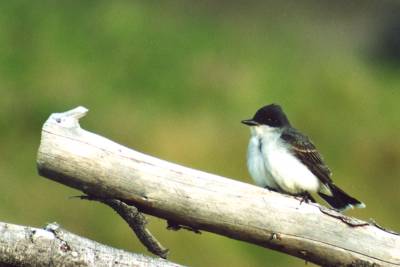
Tyrannus tyrannus is a large Tyrant flycatcher. Adults are grey-black on the upperparts with light underparts; they have a long black tail with a white tip. Their breeding habitat is open areas across North America. They aggressively defend their territory, even against much larger birds. Migrate in flocks to South America. They wait on an open perch and fly out to catch insects in flight, sometimes hovering to pick food off vegetation. They also eat berries and fruit, mainly in their wintering areas. The call is a high-pitched unmusical chirp.
Photo © Jared Clarke
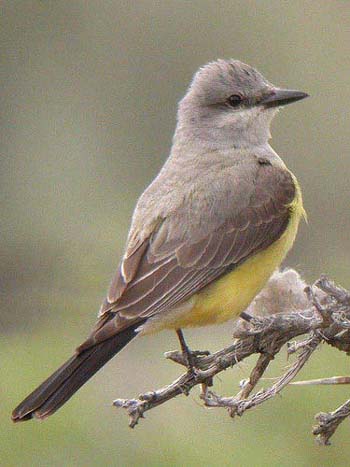
Adults are grey-olive on the upperparts with a grey head and a dark line through the eyes; the underparts are light becoming light orange-yellow on the lower breast and belly. They have a long black tail with white outer feathers. Their breeding habitat is open areas in western North America. The name kingbird is derived from their "take-charge" behavior. These birds aggressively defend their territory, even against much larger birds such as hawks. These birds migrate in flocks to Florida and the Pacific coast of southern Mexico and Central America. They wait on an open perch and fly out to catch insects in flight, sometimes hovering and then dropping to catch food on the ground. They also eat berries. The song is a squeaky chatter. The call is a sharp loud whit.
Photo © Dave Appleton
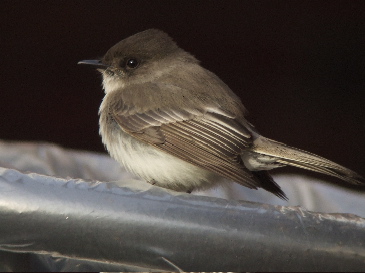
Sayornis phoebe is a small tyrant flycatcher that breeds in eastern North America, although its normal range does not include the southeastern coastal USA. It is migratory, wintering in the southernmost USA and Central America. The breeding habitat of this bird is open woodland, farmland and suburbs, often near water. This is one of the first birds to return in spring and one of the last to leave in the fall. It often nests on human structures such as bridges and buildings. The nest is an open cup with a mud base and lined with moss and grass, built in crevice in a rock or man-made site; 3-8 eggs are laid. Both parents feed the young and usually raise two broods per year. This phoebe is insectivorous, and often perches conspicuously when seeking food items. It also eats fruits and berries in cooler weather. A perching bird will repetitively pump its tail and this is often a good way to identify the bird.
Photo © Steve Huggins
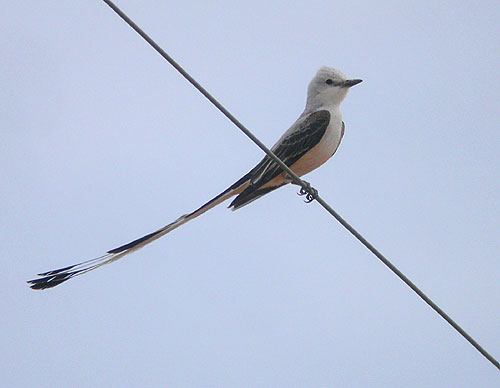
Tyrannus forficatus is a long-tailed insect-eating bird closely related to the kingbirds. Adult birds have grey upper parts and light underparts with pinkish flanks. They have dark wings and an extremely long black tail. Immature birds are duller in colour and have a shorter tail.
Their breeding habitat is open shrubby country with scattered trees in the south central United States and northeastern Mexico. They build a cup nest in a tree or shrub on a branch, sometimes using artificial sites such as telephone poles. The male performs a spectacular aerial display during courtship with his long tail streaming out behind him. Both parents feed the young. Like other kingbirds, they are very aggressive in defending their nest. They migrate to southern Mexico and Central America. They regularly stray to the ocean coasts of the US and are occasional visitors to southern Canada. These birds feed mainly on insects which they catch by waiting on a perch and then flying out to catch them in flight. They also eat some berries. This is the state bird of Oklahoma.
Photo © Richard Fray
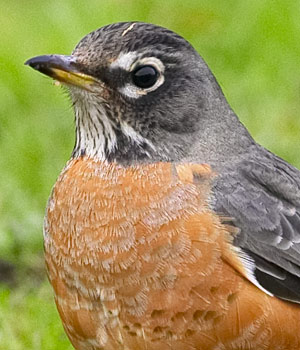
The American Robin is 25-28 cm (10-11 in) long. It has gray upperparts and head, and orange underparts, usually brighter in the male; the similarity between this coloring and that of the smaller and unrelated European Robin (Erithacus rubecula) led to its common name. There are seven races, but only T. m. confinus in the southwest is particularly distinctive, with pale gray-brown underparts. During the breeding season, the adult males grow distinctive black feathers on their heads; after the breeding season they lose this eye-catching plumage.
This bird breeds throughout Canada and the United States. While Robins occasionally overwinter in the northern part of the United States and southern Canada, most winter in the southern parts of the breeding range and beyond, from the southern U.S.A. to Guatemala. Most depart south by the end of August and begin to return north in February and March. (Exact dates vary with latitude and climate, of course.) As with many migratory birds, the males return to the summer breeding grounds before the females and compete with each other for nesting sites. The females then select mates based on the males' songs, plumage, and territory quality. The females build the nest and lay three or four blue eggs in the lined cup. Incubation, almost entirely by the female is 11-14 days to hatching, with another 15-16 days to fledging. Two broods in a season are common. The American Robin's habitat is all sorts of woodland and more open farmland and urban areas. Food is the typical thrush mixture of insects, earthworms, and berries. Robins are frequently seen running across lawns, picking up earthworms by sight or sound. This is the state bird of Connecticut, Michigan, and Wisconsin.
Photo © Jack Levene
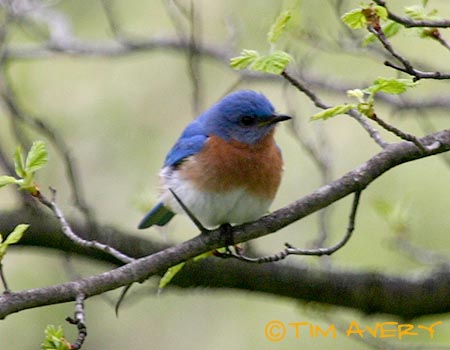
As the name implies, these are attractive birds with blue, or blue and red, plumage. Female birds are less brightly colored than males, although color patterns are similar and there is no noticeable difference in size between genders.
Bluebirds are territorial, prefer open grassland with scattered trees and are cavity nesters (similar to many species of woodpecker). Bluebirds can typically produce between two to four broods during the spring and summer (March through August in the northeast). Males identify potential nest sites and try to lure prospective female mates to those nesting sites with special behaviors that include singing and flapping wings, and then placing some material in a nesting box or cavity. If the female accepts the male and the nesting site she and she alone builds the nest and incubates the eggs.
Individuals wishing to build and mount nesting boxes for bluebirds should place predator baffles at least 36" in length on poles to prevent predation of young by snakes, cats and raccoons. Also, birdhouses should be placed at least several hundred yards apart, avoiding overhanging limbs which might provide springboards for predators. Non-native bird species competing with American bluebirds for nesting locations include the Common Starling and House Sparrow, both of which have been known to kill young bluebirds.
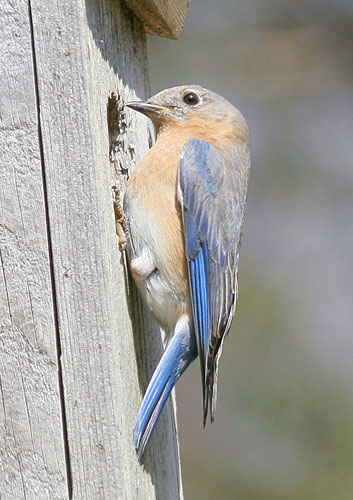
Bluebirds are attracted to platform bird feeders, filled with grubs of the darkling beetle - sold by many online bird product wholesalers as "mealworms." Some bluebird enthusiasts report the birds will eat raisins soaked in water as well. In addition, in winter many birders report bluebirds frequenting backyard heated birdbaths.
Bluebird numbers declined by estimates ranging to 70% in the 1970s due to a decline in habitat. However, in late 2005 Cornell University's Lab of Ornithology reported bluebird sightings at many locations in the southern U.S. as part of its yearly Backyard Bird Count, a strong indication of the bluebird's return to the region.
Photo © Tim Avery
Photo © Mark S. Szantyr
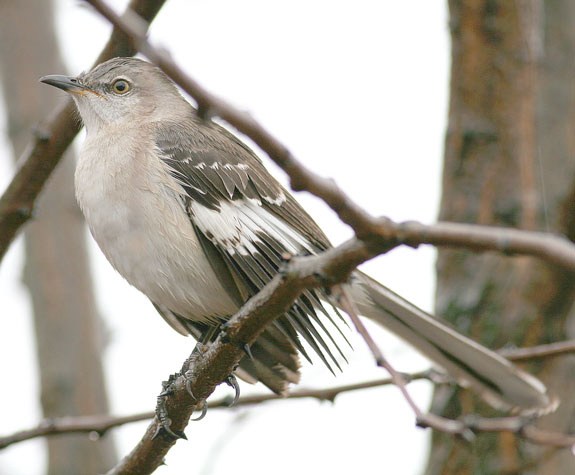
Typically found in the coastal region from Florida to Texas. They build a twig nest in a dense shrub or tree. This bird aggressively defends its nest against other birds and animals, including humans. When a predator is persistent mockingbirds from neighboring territories, summoned by a distinct call, may join the attack. Other birds may gather to watch as the mockingbirds harass the intruder.
They are generally permanent residents; northern birds may move south during harsh weather.
These birds forage on the ground or in vegetation; they also fly down from a perch to capture food. They mainly eat insects, berries and seeds. While foraging they frequently spread their wings in a peculiar two-step motion to display the white patches. The purpose of this behavior is disputed. Some ornithologists say this is purely a territorial display, while others say that flashing the white patches startles hiding insects and forces them into the open.
This bird imitates the calls of other birds, animal sounds and machine noises. It is often found in urban areas. It often sings through the night, especially when the moon is full, and may continue year-round except for the late-summer moulting season. Individual males have repertoires of 50 to 200 songs; females sing more quietly and less often than males. Mockingbirds usually sing the loudest in the twilight of the early morning when the sun is on the horizon. While singing on a high perch they will often bolt several feet into the air in a looping motion, with wings outstretched to display their white underside, then land back on the perch without breaking a note. That serves as a territorial display.
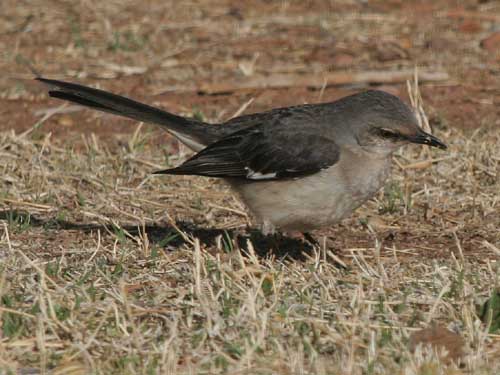
Mockingbirds' willingness to nest near houses, loud and frequent songs, and territorial defense often annoy people. John van der Linden, the author of the Eastern Birding Central FAQ, says that 25 to 50 percent of the e-mail questions he receives are about how to deal with annoying mockingbirds.
Mockingbirds have a strong preference for certain trees such as maple, sweetgum, and sycamore. They generally avoid pine trees after the other trees have grown their leaves. Also, they have a particular preference for high places, such as the topmost branches of trees and the tops of telephone poles. In urban areas, mockingbirds rarely come down to the ground, unlike many birds.
Photo © Mark S. Szantyr
Photo © Sean Cronin

Bombycilla cedrorum is a member of the family Bombycillidae or waxwing family of passerine birds. It breeds in open wooded areas in North America, principally southern Canada and the northern United States. Movements outside the breeding season are erratic, but most of the population migrates further south into the United States.
Cedar Waxwings eat berries and fruit year-round, including arils of the yew, with insects becoming an important part of their diet in the breeding season. Its fondness for the small cones of the Eastern Redcedar (a kind of juniper) gave this bird its common name. This species is eruptive, moving south in huge numbers if the berry supply fails in winter. It feeds in flocks outside of the nesting season. When the end of a twig holds a supply of berries that only one bird at a time can reach, members of a flock may line up along the twig and pass berries beak to beak down the line so that each bird gets a chance to eat.
Birds in winter can be very confiding and will come into gardens for berry bushes and trees.
Its flight is strong and direct, and in flight it looks like a small pale starling. It is smaller and browner than the Bohemian Waxwing, which breeds further north and west than the Cedar Waxwing in the North American part of its range. The tail is tipped with yellow, or orange in birds that have fed on berries of introduced Eurasian honeysuckles while growing tail feathers after molt. Adults have a pale yellow belly. Immature birds are streaked on the throat and flanks, and often do not have the black mask of the adults.
The nest is a loose open cup built with grass and twigs, lined with softer materials and supported by a tree branch averaging 2 to 6 meters above ground but, at times, considerably higher. The outer diameter of the nest is approximately 12cm to 16cm.
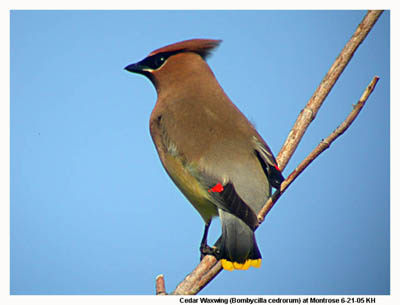
During courtship, the pair may pass a flower petal or insect back and forth repeatedly. Usually 4 or 5 eggs are laid and the female incubates them for 12 to 16 days. The eggs are oval shaped with a smooth surface and very little, if any, gloss. The egg shells are of various shades of light or bluish grey with irregular, dark brown spots or greyish-brown splotches. Both parents build the nest and feed the young. Typically, there are two broods during the mating season. Young leave the nest about 14 to 18 days after hatching.
The calls of these birds include very high-pitched whistles and buzzy trills often represented as "see" or "sree".
Photos © Kanae Hirabayashi
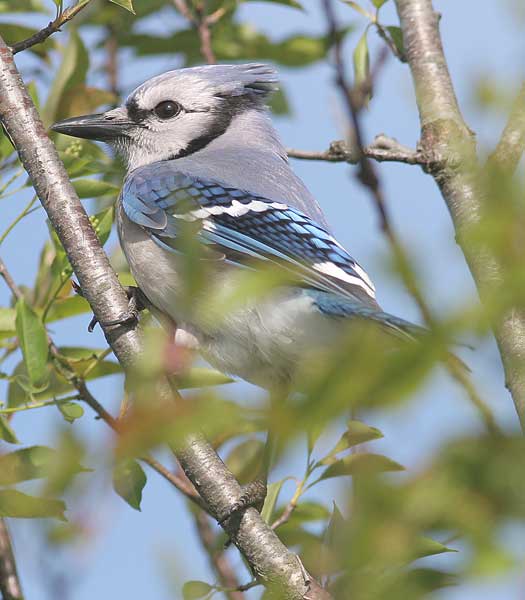
Cyanocitta cristata is a North American jay, a handsome bird with predominantly lavender-blue to mid-blue feathering from the top of the head to midway down the back. There is a pronounced crest on the head. The colour changes to black, sky-blue and white barring on the wing primaries and the tail. The bird has an off-white underside, with a black collar around the neck and sides of the head and a white face.
Blue Jays reside over a very large area of the eastern side of North America from Newfoundland in the northeast to Florida in the southeast and westward to Texas and the mid-west and eastern Colorado in the north. It is mainly a bird of mixed woodland, including American beech and various oak species, but also of parks and gardens in some towns and cities. West of the Rockies, it is replaced by the closely related Steller's Jay.
Its food is sought both on the ground and in trees and includes virtually all known types of plant and animal sources, such as acorns and beech mast, weed seeds, grain, fruits and other berries, peanuts, bread, meat, eggs and nestlings, small invertebrates of many types, scraps in town parks and bird-table food.
Its aggressive behavior at feeding stations as well as its reputation for occasionally destroying the nests and eggs of other birds has made the Blue Jay unwelcome at some bird feeders.
Any suitable tree or large bush may be used for nesting and both sexes build the nest and rear the young, though only the female broods them. There are usually 4-5 eggs laid and incubated over 16-18 days. The young are fledged usually between 17-21 days. Blue Jays typically form monogamous pair bonds for life.
Although this bird is generally found year round through most of its range, some northern birds do move into the southern parts of the range. These birds migrate during the day.
The voice is typical of most jays in being varied, but the most common sound is usually the alarm call, which is a loud, almost gull-like scream. There is also a high-pitched jayer-jayer call that increases in speed as the bird becomes more agitated.
Photo © Mark S. Szantyr
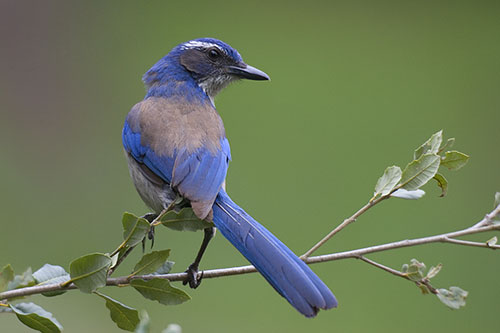
The scrub jays are slightly larger than the Blue Jay, and differ in having a longer tail, slightly shorter, more rounded wings and no crest on the head. The top of the head, nape and sides of the head are a rich deep blue, in some species with a white stripe above the eye and dark ear coverts. The breast is also white or grey-white and the back is a grey-brown contrasting with the bright blue tail and wings in most species. The bill, legs and feet are black.
Photo © Ray Wilson
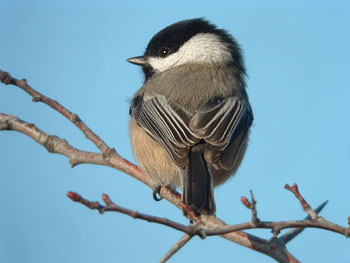
Parus atricapillus or Poecile atricapillus, is a small songbird, a passerine bird in the tit family Paridae.
Adults have a black cap and bib with white sides to the face. Their underparts are white with rusty brown on the flanks; their back is grey. They have a short dark bill, short wings and a long tail.
Their breeding habitat is mixed or deciduous woods in Canada, Alaska and the northern United States. They nest in a hole in a tree; the pair excavates the nest, using a natural cavity or sometimes an old woodpecker nest. They may interbreed with Carolina Chickadees or Mountain Chickadees where their ranges overlap.
They are permanent residents, but sometimes move south within their range in winter. On cold winter nights, these birds reduce their body temperature to conserve energy.
The call is the familiar chick-a-dee-dee-dee which gave this bird its name. Recent study of the call shows that the number of dees indicates the level of threat from nearby predators. An analysis of over 5,000 alarm calls from chickadees, it was found that alarm calls triggered small, dangerous raptors had a shorter interval between "chick" and "dee" and tended to have extra "dees", usually averaging four instead of two.
Photo © Robert Hughes
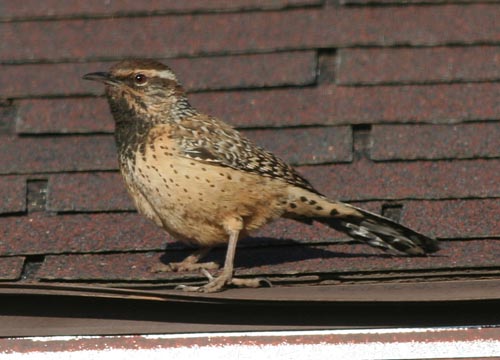
Campylorhynchus brunneicapillus is the largest North American wren, and is 18-23 cm (7-9 inches) long.
Unlike the smaller wrens, the Cactus Wren is easily seen. It has the loud voice characteristic of wrens, but its song is harsh and unmusical, and it is much less shy than most of the family. Its marked white eyestripe, brown head, barred wings and tail, and spotted tail feathers make it easy to identify. Like most birds in its genus, it has slightly curved bill. There is little sexual dimorphism.
The Cactus Wren is native to the south-western United States southwards to central Mexico. It is a bird of arid regions, and is often found around yucca, mesquite or saguaro; it nests in cactus plants, sometimes in a hole in a saguaro, sometimes where its nest will be protected by the prickly leaves of a cholla or yucca. It mainly eats insects, though it will occasionally take seeds or fruits. It rarely drinks water, getting its moisture from its food.
The Cactus Wren forms permanent pair bonds, and the pairs defend a territory where they live all through the year.
It is the state bird of Arizona.
Photo © Sean Cronin
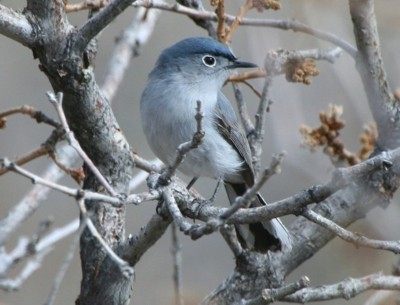
Polioptila caerulea, is a very small songbird.
Adults are blue-grey on the upperparts with white underparts, with a long slender bill and a long black tail. They have a white eye ring.
Their breeding habitat is open deciduous woods and shrublands in southern Ontario, the eastern and southwestern United States and Mexico. They build a cup nest similar in construction to a hummingbird nest on a horizontal tree branch. Both parents construct the nest and feed the young; they may raise two broods in a season.
These birds migrate to the southern United States, Central and South America.
They forage actively in trees or shrubs, mainly eating insects, insect eggs and spiders. They may hover over foliage or fly to catch insects in flight.
The tail is often held upright while defending territory or searching for food.
Photo © Glenn Walbek
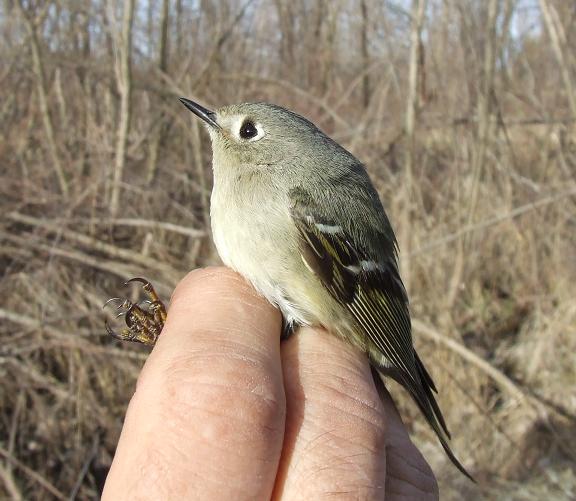
Regulus calendula is a very small songbird.
Adults are olive-grey on the upperparts with light underparts, with a thin black bill and a short tail. They have white wing bars and a white broken eye ring. The adult male has a red patch on his crown which is usually only visible when he is agitated.
Their breeding habitat is coniferous forests across Canada, Alaska, northern New England and the western United States. They nest in a well-concealed hanging cup suspended from a conifer branch and may lay as many as twelve eggs in a clutch.
The recent counting indicates that the Ruby-crowned kinglet population is on the rise. This is mainly due to discovery of less disturbed territory farther north. This allows more successful breeding.
These birds migrate to the southern United States and Mexico. Some birds are permanent residents in the west.
They forage actively in trees or shrubs, mainly eating small insects and spiders, some berries and tree sap. They may hover over a branch while feeding and sometimes fly out to catch insects in flight.
Their song is a melodious warble and fairly loud, but at least in winter habitat, the most common vocalization is a wren-like scolding "jdit", often repeated several times in close succession.
Photo © Neil Gilbert
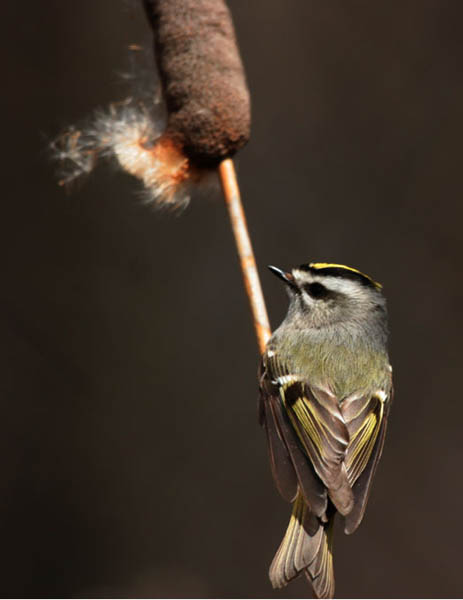
Regulus satrapa, is a very small songbird.
Adults are olive-grey on the upperparts with white underparts, with thin bills and short tails. They have white wing bars, a black stripe through the eyes and a yellow crown surrounded by black. The adult male has an orange patch in the middle of the yellow crown.
Their breeding habitat is coniferous forests across Canada, the northeastern and western United States, Mexico and Central America. They nest in a well-concealed hanging cup suspended from a conifer branch.
These birds migrate to the United States. Some birds are permanent residents in coastal regions and in the southern parts of their range. Northern birds remain further north in winter than the Ruby-crowned Kinglet.
They forage actively in trees or shrubs, mainly eating insects, insect eggs and spiders.
They give a series of high-pitched calls on a single note, and tend not to fear human approach.
Photo © Kanae Hirabayashi
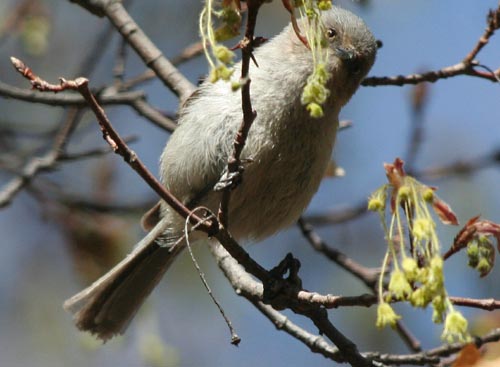
Psaltriparus minimus is a long-tailed tit found in North America. It is the only species in the family found in the New World, and the only member of the genus Psaltriparus.
Bushtits inhabit mixed open woodlands, often containing oaks and a scrubby understory. They are year-round residents of the western United States and highland parts of Mexico, ranging from Vancouver through the Great Basin and the lowlands and foothills of California, to southern Mexico and Guatemala.
The Bushtit is one of the smallest passerines in North America, at 11 cm in length and 5.3 g in weight. It is gray-brown overall, with a large head, a short neck, a long tail, and a short stubby bill. It has dark eyes, except that adult females have yellow eyes.
"Black-eared" Bushtits also have a dark ear patch (the auriculars). This morph was formerly considered a separate species (P. melanotis). It doesn't occur in the northern part of the range; as one moves south it's first noted near the Mexican border, mostly in Texas. Here most individuals with the black ear patch are juvenile males, and none are adult females. Some birds have only one or two dark lines on the face instead of a complete patch. Black-eared birds become more common southward in the northeastern (but not the northwestern) highlands of Mexico until from central Mexico south, all males have a complete black ear patch and even adult females have a black arc over the eye and usually a black line through the eye.
Bushtits are active and gregarious, foraging in cohesive groups of 10 to over 40 for small insects and spiders. Members of the group constantly make contact calls to each other that can be described as a short tsit.
As "plain" Bushtits lack major identifying markings, they are often identified by their shape, calls, and behaviors. Bushtits are the only species of small bird inhabiting the western United States that regularly hang upside-down for extended periods.
Photo © Sean Cronin
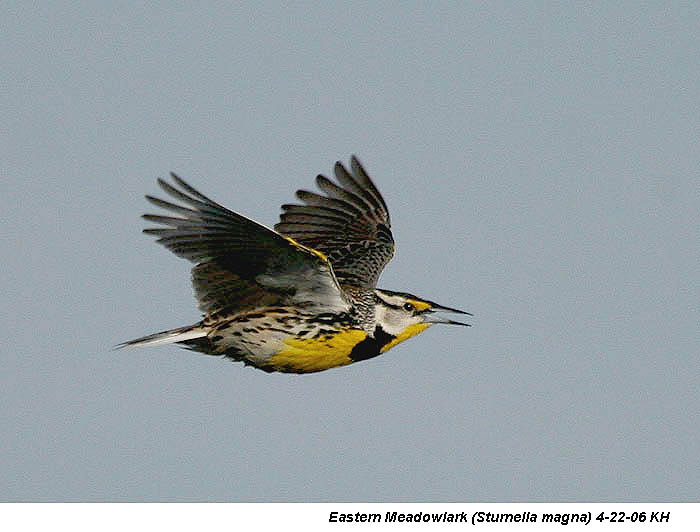
The Western Meadowlark (Sturnella neglecta) is a medium-sized blackbird, very similar in appearance to the Eastern Meadowlark.
Adults have yellow underparts with a black "V" on the breast and white flanks with black streaks. The upperparts are mainly brown with black streaks. They have a long pointed bill; the head is striped with light brown and black.
Their breeding habitat is grasslands and prairie, also pastures and abandoned fields, across western and central North America to northern Mexico. Where their range overlaps with the eastern species, these birds prefer thinner, drier vegetation; the two birds generally do not interbreed but do defend territory against each other. The nest is on the ground, covered with a roof woven from grasses. There may be more than one nesting female in a male's territory.
These birds are permanent residents throughout much of their range. Northern birds migrate to the southern parts of the range; some birds also move east in the southern United States.
These birds forage on the ground or in low to semi-low vegetation, sometimes probing with its bill. They mainly eat insects as well as seeds and berries. In winter, they often feed in flocks.
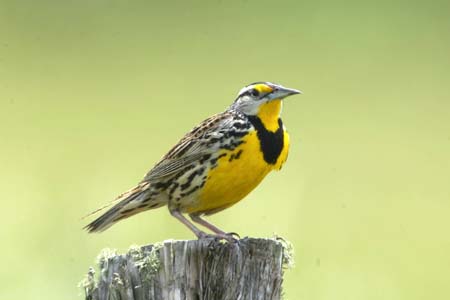
This bird has a flute-like warbled song, unlike the simple whistled call of the Eastern Meadowlark. They were considered to be the same species for some time; the western species, having been overlooked for some time, was given the species name neglecta.
This is the state bird of Kansas, Montana, Nebraska, North Dakota, Oregon and Wyoming.
Photo © Kanae Hirabayashi
Photo © Chris Brogdale